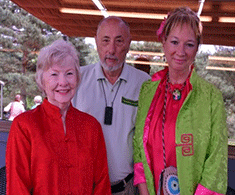Building CCT-US from the Ground Up
Commander Stephen F. Snell, U.S. Navy (Retired)
This article provides some background information on the formation of the Chagos Conservation Trust – US (CCT-US), explains our relationship to the Chagos Conservation Trust resident in the UK, introduces the Board of CCT-US, and provides a brief outline of our approach to our organizational structure, our outreach efforts, and solicitation of charitable donations in the United States to support initiatives consistent with the vision and goals of CCT-US.
I. Vision for US branch of CCT
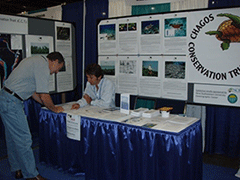 |
Sam Purkis signs up one of the first members of the CCT-US at the 11th ICRS in Ft. Lauderdale, Florida, 2008 |
When Friends of Chagos/Chagos Conservation Trust was formed by Commander John Topp RN (Retired), OBE, and others in 1992 in the UK, it was only a matter of time before some initiative would be taken to establish a sister organization in the USA. John and I spent coincident time on Diego Garcia in 1984 and enjoyed one another’s company, most notably on Sunday evenings over a rubber of bridge and some single malt whisky. John reached out to me almost immediately when CCT was formed, and I signed up just as quickly as one of the early members of the trust. William Marsden was also instrumental in the formation of a CCT-US, and he played a key role in connecting the respective boards. William had met both Dr. Sam Purkis, who was a resident professor at Nova Southeastern University in Fort Lauderdale, Florida, and Carol Garner from Mount Vernon, Ohio. Carol, as it turned out, had significant experience in charitable and non-profit fundraising. I became the third piece of the puzzle which was to form the leadership team of CCT-US from what must have derived from my 13 months on Diego Garcia in 1983-84.
By the time Sam, Carol, and I had connected via teleconference, Sam was already ahead of the pack. The CCT-US launched itself with a booth at the 11th International Coral Reef Conference in Fort Lauderdale, Florida (2008).
II. Establish a Solid Organizational Foundation: Staff
CCT-US could not have been more fortunate to have assembled an ideal match of complementary skills that would serve us well as we attempted to establish a solid foundation for a new organization. Sam, Carol, and I have established a strong working relationship, and as we each have our strengths, it is not difficult to distribute needed tasks to the right talent. And not one of the three of us seems to be shy about taking on responsibility.
Permit me to introduce the 3 Co-Founders of CCT-US and provide some background detail
Chair: Due to professional obligations as department chair for Marine Sciences at the University of Miami, our former Chair and Co-Founder, Sam Purkis, has recently stepped down in order to allow a fresh face with new ideas to devote more time to the Trust than Sam has available.
Introducing the new Chair of CCT-US, Ted Morris. Welcome Ted!!!
Ted A. Morris, Jr., graduated from the University of Montana with a Bachelor of Arts, with Honors, in Environmental Biology, and entered the United States Air Force as a Distinguished Graduate of the Reserve Officer Training Corps. He served 20 years in the Air Force as an officer and pilot, including a tour of duty on Diego Garcia in the British Indian Ocean Territory, where he developed a life-long interest in the Chagos Archipelago, its history, and its ecology.
Following his retirement from military service, he worked as an executive for the Boy Scouts of America and as the Manager of an International Airport. Following the attacks of September 11, 2001, Ted returned to government service and spent three years in combat operations in the Iraq and Afghanistan theatres, following which he rejoined his loving wife in their New Mexico home. They have three children and three grandchildren.
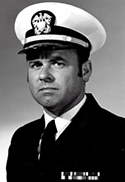 |
On Diego Garcia in 1983, displaying the stern demeanor required of an Executive Office |
Vice Chair and Treasurer: Steve Snell was an early CCT member. He is a retired Naval officer, and was assigned to Diego Garcia as Executive Officer of the U.S. Naval Communication Station in 1983 and 1984. After retirement from the Navy, he worked for 20 years in a Fortune 500 corporation in the computer sciences. He has strong organizational skills, and coincidentally has past experience as Treasurer of another tax-sheltered charitable organization.
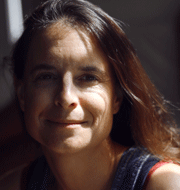 |
Membership Secretary: Lotte Purkis is a GIS consultant and marine cartographer who has produced maps for tens of thousands of square kilometers of the world’s seabed, including the Chagos Archipelago. Lotte runs her own consultancy working with clients such as UNDP, IUCN, the Smithsonian Institute and The Nature Conservancy. Lotte graduated from the University of Southampton, U.K. with a B.Sc. Hons in Oceanography and Chemistry and then went on to earn her M.Sc. in International Development Management from the Open University, U.K., specializing in inter-organizational relations and the wider socio-economic impacts of not-for-profit foundations. Lotte lives with her husband Dr. Sam Purkis in Miami together with their two daughters. |
Advisory Board Members
CCT-US is fortunate that our two former Board members and Co-Founders have agreed to remain with the Trust in an advisory role. We welcome the contributions and experience of both Dr. Sam Purkis and Carol Garner.
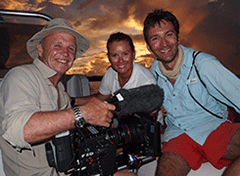 |
| Sam Purkis (right) with Alex Dempsey, Coral Reef Ecologist with the Living Oceans Foundation (LOF) (center) and cameraman Doug Allen (left) filming in Peros Banhos Lagoon, Chagos, 2015 |
Sam Purkis, PhD, is the Professor and Department Chair, Department of Marine Geosciences, University of Miami Professor Oceanographic Center, Miami, Florida. He thus has a foundation in the sciences, credibility in academia, and also delivers strong links back to CCT through his personal acquaintances. His work stretches from field monitoring, GIS, to software development and mathematical simulation. Sam has authored more than 80 scientific publications including several books. Sam is well versed in state-of-the-art technological solutions for seabed mapping, and his expertise is relevant to a broad spectrum of marine applications.
Carol Garner; Carol has extensive and exceptional experience in fund-raising, large-scale capital campaigns and grant application writing for non-profits and charitable organizations, and conducting public and private fund-raising campaigns. She is adept at public relations and outreach; as such, she was CCT-US’ own goodwill ambassador extraordinaire. |
|
III. Establish a Solid Organizational Foundation: Legal, Tax Status, Corporate Direction
With Sam, Carol, and Steve in place as Co-Founders of CCT-US, we set out to get ourselves established officially, legally, and with the approval of the Internal Revenue Service for tax purposes. Our first effort was to compose a vision statement to bound our potential activities. Our vision statement encompassed three focal points: conservation, scientific research, and education as relates to the Chagos Archipelago. It was always our intent to create a sister organization that retained its independence and freedom of thought, while at the same time was able to act in concert with CCT in the UK and provide value-added to tangible and meaningful preservation goals. After defining our vision, we developed By-Laws and Articles of Incorporation, which were filed in the State of Ohio as a matter of convenience for Carol since she lives in Ohio.
Following incorporation, our next major task was to file for non-profit charitable status (known as 501(c)(3) after a section of the Internal Revenue Service (IRS) Code) with the IRS. While there are many individuals and organizations willing to shepherd the application through the IRS for a fee, we were budget-limited and did all the work ourselves. Through Carol’s connections we did engage in a pro bono legal review prior to submission. We achieved our 501(c)(3) approval on February 10, 2010. The significance of the approval was huge, as it meant that charitable contributions could be made by organizations or individuals who would enjoy tax deductions.
We next developed a Strategic Plan with detailed Goals & Objectives to guide our schedule of activities and ambitions. Of vital importance, the Goals & Objectives were resource-constrained by linkage to our corporate budget documents. Although our achievements at this early stage are modest, CCT-US has nonetheless accomplished many things. Of note, we were able to fund the CCT-US Expedition Scholarship program and sent one scholar, Dr. Doug Fenner, to Chagos in 2014. This program is ongoing and is the centerpiece of our investment of donated funds.
IV. Establish a Solid Organization Foundation: Outreach
At the outset, we were faced with a real challenge to not only gain name recognition among the myriad of charitable organizations in the USA, but to do so in a professional manner to establish our credibility as a charity worthy of both participation and donations. To most in the USA, Chagos is either unknown, or is so remote as to not register on the public consciousness. Our efforts at outreach, therefore, are as much about educating the public as anything else.
In setting out to answer the questions: Who is CCT-US? and What do we do? we very quickly built a website and hosted it on the Internet ( see www.cctus.org ); we have Gwilym to thank for all the hard work in bringing the website to reality—an effort that was performed with virtually no expenditure of resources. Carol has also championed our cause in social media by building and maintaining a FaceBook page ( www.facebook.com/chagosconservationtrustus ).
 |
From L to R: John Parks, Executive Officer of John Parks consulting LLC; Alistair Gammell, Director Pew Environmental Group Chagos Campaign; Carol Garner, and Suzanne Taei, Marine Program Director, Conservation International Apia, Samoa |
We are identifying candidate US-based conservation entities (e.g., the Loggerhead Marinelife Center (http://www.marinelife.org/ )) for potential strategic alliances. We are additionally seeking out other interest groups within commonalities to our corporate vision. One such interest group, Big Ocean, a network of the world’s large-scale maritime protected areas (MPAs) hosted a meeting in 2011 in Victoria, British Columbia, Canada which was attended by our own Carol Garner representing CCT-US with full support from CCT in the UK.
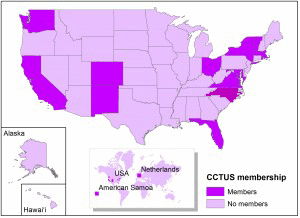
We have a great deal yet to do in expanding our outreach. By example, there is a large cadre of present and former US military personnel who have been assigned to Diego Garcia who are potential candidates for involvement in CCT-US. While our membership numbers are modest, we have members in 12 states and territories and one foreign country. The pool of former residents of Diego Garcia represents a resource that is yet to be tapped.
V. Establish a Solid Organization Foundation: Fundraising
Our approach to fundraising has had to conform to some fundamental realities. While these realities will change over time, for the time being we must be guided
- Capitalize on a tax structure in the USA which encourages charitable donations—from individuals, from corporations, from foundations, from trusts; be mindful and be respectful of constraints on donations such as limitations on the flow of funds outside the country in the wake of 9-11
- Recognize our small beginnings; keep our objectives manageable, which keeps our fundraising goals manageable
- Keep growth objectives in fundraising reasonable– so far a 33% positive return rate on tendered proposals
- Cultivate partnerships with corporate and individual donors
- Publicize to donors the returns on our investment of their donations in scientific or educational achievement
- Strive to advertise the CCT-US through public speaking and other public events to solicit donations, however large or small
VI. Summary
From humble beginnings, CCT-US is gaining good traction in its efforts to remain a viable force in environmental preservation and education for many years to come. We will continue to strive to serve as an equal partner with CCT in the UK as we pursue common objectives. We recognize the synergies that can be realized by applying the resources of two organizations against these common objectives, instead of just one. While our constituents and the legal framework in which we live and work are vastly different from those in the UK, CCT-US can and will bring new perspectives to our ecological challenges.

 Chagos Conservation Trust – US
Chagos Conservation Trust – US